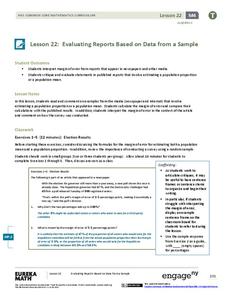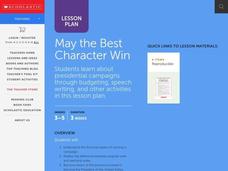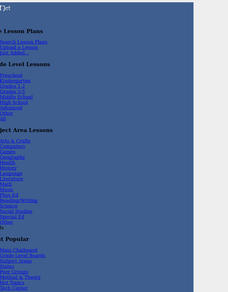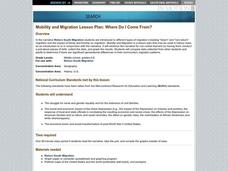Curated OER
Go Yankees!
Students use the internet to research the New York Yankees baseball team. After gathering their information, they discuss the challenges faced by the team and how they were overcome. They end the lesson by examining the math and...
Curated OER
Mind your Manners Guys on your First Date
Students read an article that outlines the things one should not do when eating out on a first date. In this lesson, students complete several activities to reinforce comprehension of the article, including a vocabulary assignment, a...
PBS
The History and Use of Sampling Methods
Young mathematicians define population, draw convenience sample from the population, draw quota sample from the population, and draw random probability sample from the population. They explain why a random probability sample usually...
EngageNY
Evaluating Reports Based on Data from a Sample
Statistics can be manipulated to say what you want them to say. Teach your classes to be wise consumers and sort through the bias in those reports. Young statisticians study different statistical reports and analyze them for misleading...
EngageNY
Divisibility Tests for 3 and 9
Who knew the sum of a number's digits gives such interesting information? The 18th installment of a 21-part module has scholars investigate division by three and nine. After looking at several examples, they develop divisibility tests...
Curated OER
Rights of the Accused in Search and Seizure
Students explain the rationale behind the Fourth Amendment, and the types of activity regulated by the Constitution. They analyze situations, and explain a citizen's rights when an unlawful search or seizure is conducted.
Curated OER
May the Best Character Win
Running an election campaign takes money. Class groups must effectively budget money in order to design and purchase sufficient advertising aimed at procuring classmates' votes. After completing an online tutorial, they also write and...
iCivics
You've Got Rights!
If aliens invaders nearly destroy the world in the distant future and leaders must decide on a pamphlet of protections to preserve individual rights, what should they include? Introduce the Bill of Rights and the struggle between the...
Curated OER
The Economics of Voting
Students examine the voting behavior of people during a presidential election to determine costs and the benefits of voting and how this behavior is influenced by incentives.
Curated OER
Survey Says...
Young learners create and implement a school-wide survey about student body favorites! Learners record and analyze the data on a bar graph, picture graph, and line graph, and then display the data. Then, wrap it all up with a celebration...
Curated OER
How Did Humans Evolve?
Students complete an online activity in which they examine fossils to find possible hominid family trees.
Curated OER
Meeting and Reading Dr. Seuss
Second graders demonstrate competence in the general skills and strategies of the reading process.
Curated OER
Why Can't I Vote?
Fourth graders take an unannounced test (failure is expected) and the top scores are rewarded with candy bars. They compare this test to the literacy tests given before 1960 and votes to candybars. They journal their responses.
Curated OER
Amnesty:More Than A Word
Students examine two advertisements, both of which claimed a 2007 immigration reform bill would provide "amnesty" to illegal immigrants. They research a bill and check the accuracy of advertising claims. Afterward, they write their own,...
Curated OER
Debate: Is Cheerleading a Sport?
Students research how women are perceived in sports. They debate the issue of whether cheer leading should be considered a sport and are scored on student made rubrics.
Curated OER
Voting And Elections
Students examine the voting practices of the past several presidential elections while using data to determine the influence of different factors. They identify the reasons for high or low voter turnout and then display the outcome of...
Curated OER
Democracy Sense
Students define democracy and distinguish representative from direct or pure democracy. Then, with the focus on representative government, students will discuss and trace voting patterns in the United States.
Curated OER
Is London Bridge Really Going to Fall Down?
Learners discover what forces work together to hold up a suspension bridge. They see various bridges around the world, and learn the basic principles that enable each bridge to support itself. Groups design their own bridge, testing how...
Curated OER
Law & Ethics for Photojournalists
Students identify and discuss First Amendment rights, examine how to make sound legal judgements regarding photographs of private individuals, examine difference between public and private figures as far as libel law is concerned,...
Curated OER
It's in the Paper! (Newspaper In Education Unit)
Fourth graders brainstorm a list of the kinds of information found in newspapers, present examples, and state how reading a newspaper is useful to them and people they know.
Curated OER
WHERE DO I COME FROM?
Students analyze the struggle for racial and gender equality and for the extension of civil liberties, the social and economic impact of the Great Depression, and the economic boom and social transformation of post-World War II United...
Curated OER
Your Vote Counts! Election Activity
Students participate in a simulated election. They serve as 'checkers', marking off names of those who vote, a ballot person hands out ballots, and ballot sorters and counters. Teacher rigs up a voting booth where voters mark ballots...
Curated OER
Properties of Triangles
Students explore the relationship between how big a side of a triangle is and how big its opposite angle is by creating triangles using an interactive website.
Curated OER
United States Entry into World War I: Some Hypotheses About U.S. Entry
Students take a stand on a hypothesis for U.S. entry into World War I, supported by specific evidence.

























